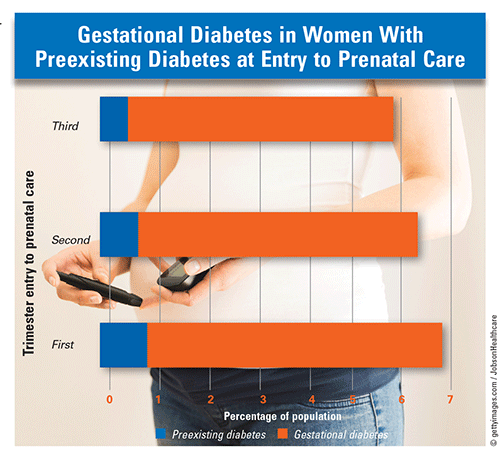US Pharm. 2020;45(11):14.
The CDC has stated that preexisting diabetes and gestational diabetes (GD) increase the risk of adverse maternal and infant health outcomes. Among 3.8 million women with diabetes who received prenatal care in 2016, 77.2% (3 million), 16.7% (0.6 million), and 6.1% (0.2 million) were in their first, second, and third trimester, respectively, upon entry to care. Among those with preexisting diabetes, 0.9% began prenatal care in the first, 0.8% in the second, and 0.7% in the third trimester, respectively. The occurrence of GD decreased with entry to prenatal care in the first (6.2%), second (5.6%), and third trimester (4.6%), respectively.

Parity: Of the 3.9 million pregnant women who had diabetes, 38.2%, 32.2%, and 29.7% were nulliparous, primiparous, and multiparous, respectively. In 2016, the prevalence of preexisting diabetes was identical in nulliparous and primiparous women and 25% higher in multiparous women. The incidence of GD in multiparous women was 13.5% higher than in primiparous women and 36.5% higher than in nulliparous women.
Age and Race/Ethnicity: Stratified by age, 29.1% (1.15 million), 28.2% (1.11 million), and 17% (0.67 million) of pregnant women with diabetes were aged 25 to 29 years, 30 to 34 years, and 35 years and older, respectively. Prevalence of preexisting diabetes increased with age. Between ages 20 and 40 years, the prevalence of preexisting diabetes increased by 40%, and it increased by 50% in those aged 40 years and older. GD incidence increased with age progression, from 1.9% in those aged 20 years and younger to 12.8% in those aged 40 years and older. Prevalence of preexisting diabetes among pregnant women was highest in American Indians (2.1%), followed by Pacific Islanders (1.8%), non-Hispanic blacks (1.2%), Hispanics (1%), Asians (0.9%), and non-Hispanic whites (0.7%). GD prevalence was highest in Asian women (11.1%), followed by American Indians (9.2%), Pacific Islanders (8.4%), Hispanics (6.6%), non-Hispanic whites (5.3%), and non-Hispanic blacks (4.8%).
BMI: Among underweight women, prevalence rates of preexisting diabetes and GD were 0.3% and 2.9%, respectively. The prevalence of both preexisting diabetes and GD varied by prepregnancy BMI, and both types of diabetes increased with greater BMI. The prevalence of preexisting diabetes was 0.8% in overweight women compared with 0.4% in women with a normal prepregnancy weight. With increasing prepregnancy BMI, the rate of preexisting diabetes increased from 54% to 63%; the incidence of GD rose 69.4% as BMI increased from normal weight to overweight. The rate of increase rose from 24.1% to 44.3% for respective prepregnancy obesity classes I through III.
The content contained in this article is for informational purposes only. The content is not intended to be a substitute for professional advice. Reliance on any information provided in this article is solely at your own risk.
To comment on this article, contact rdavidson@uspharmacist.com.





